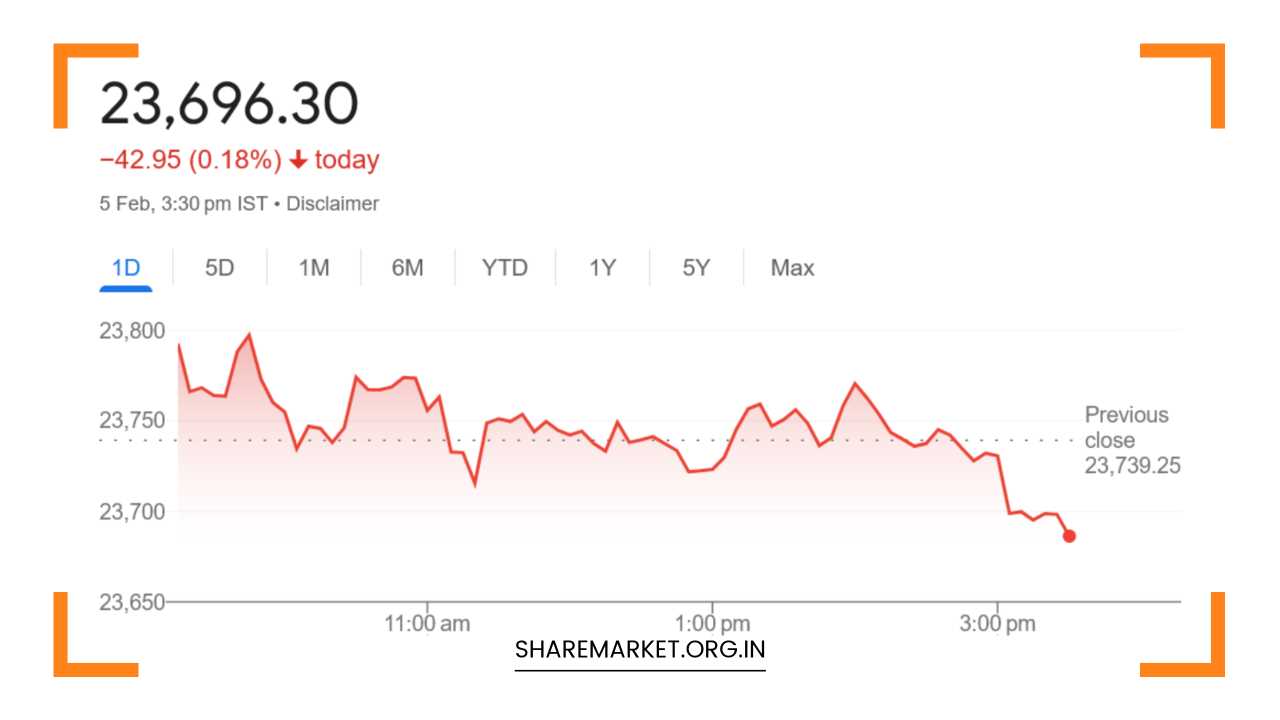Sensex Down 312 Points, Nifty at 23,696; Tomorrow Nifty Prediction

Tomorrow Nifty Prediction
Market Recap: February 5 – A Day of Decline, Key Levels to Watch for February 6
The Indian stock market ended on a negative note on February 5, 2025, despite a positive opening. While the market began strong, it encountered significant resistance near the 23,800 level, leading to a reversal in its upward trajectory.
By the close of trading, the Nifty settled at 23,696.30, marking a decline of 42.95 points, or 0.18%, while the Sensex ended at 78,271.28, down by 312.53 points, or 0.40%.
Stock Market Overview:
The Indian equity indices closed lower on February 5. The Nifty index, which had started the day with a bullish sentiment, slipped below the crucial 23,700 level, signaling a pullback in the market.
Despite initial optimism, the market failed to maintain its upward momentum. Sensex, which tracks the broader market, also faced a similar decline, falling 312.53 points to close at 78,271.28.
Among the major stocks, companies like Asian Paints, Titan Company, Nestle India, Hindustan Unilever (HUL), and Britannia Industries faced significant selling pressure, which contributed to the day’s overall decline on the Nifty index.
On the other hand, Hindalco Industries, ONGC, Apollo Hospitals, BPCL, and Adani Ports were among the top gainers, offering some relief amidst the broader market weakness.
On a sectoral basis, most indices ended in the green, except for the FMCG, Consumer Durables, Realty, and Auto sectors, which faced declines.
The Oil and Gas, Metal, Media, Energy, and PSU Banks sectors were among the best-performing segments, gaining between 1% and 1.8%.
This rally in select sectors helped offset some of the losses from broader market weakness. Notably, the Nifty Midcap Index gained 0.7%, and the Nifty Smallcap Index rose nearly 2%, indicating that mid and small-cap stocks showed resilience and outperformed the benchmark indices.
The market’s mixed performance reflects a broader sentiment of cautious optimism, as investors remain hopeful but are also wary of potential headwinds.
While mid and small-cap stocks showed relative strength, large-cap stocks faced selling pressure. This bifurcation suggests that investors are carefully picking their spots, with a focus on quality stocks in specific sectors that have a favorable outlook.
Expert Insights:
Vinod Nair, Head of Research at Geojit Financial Services, observed that the domestic market traded in a narrow range amid an overall negative environment.
On one hand, investors were buoyed by the favorable budget announcements, which provided optimism for the near-term economic outlook.
On the other hand, growing concerns around global uncertainties, such as the ongoing tariff war between major economies, led to caution among market participants.
However, there were also some positive drivers supporting the market. The fall in US bond yields and the softening of crude oil prices helped alleviate some concerns about global inflationary pressures.
These factors provided a tailwind to the market, allowing certain sectors to post gains. Despite this, the weakening of the Indian rupee is acting as a counterbalance to these positive developments, weighing on investor sentiment.
The rupee’s decline could potentially lead to higher import costs and negatively impact companies that rely heavily on imports, especially in the energy and raw materials sectors.
Nair also highlighted that there has been increasing attention on interest rate-sensitive sectors ahead of the Reserve Bank of India’s (RBI) likely decision to cut interest rates.
The banking, real estate, and automotive sectors tend to benefit from lower interest rates, and investors are keeping a close watch on these areas.
Large-cap stocks, in particular, continue to show strength as they are benefiting from attractive valuations, which could make them more appealing to long-term investors looking for safer bets in uncertain times.
Aditya Gaggar, Director at Progressive Shares, offered a more technical perspective, noting that the market faced significant resistance around the 23,800 level.
This level acted as a crucial point where the market failed to sustain its bullish momentum, triggering a reversal.
The 23,780 mark, which coincides with both the falling wedge pattern and the 50-day moving average (50DMA), is now a critical resistance level for the Nifty.
Gaggar pointed out that the market’s failure to break above this level is a short-term negative signal, but it also suggests that once the resistance is cleared, the Nifty could be poised for a move toward the next psychological level at 24,000.
On the downside, Gaggar noted that 23,520 is an important support level for the market. This level has historically acted as a floor for the Nifty, and if the market falls below this threshold, further downside could be expected.
As a result, investors should pay close attention to whether the Nifty manages to hold above this support level in the coming days.
He described the market as a “buy on dips” scenario, suggesting that dips could present opportunities for buying if the market remains resilient at key support levels.
Gaggar also observed that despite the broader market’s weakness, mid and small-cap stocks continued to show positive momentum.
These stocks outperformed the large-cap stocks, with mid and small-cap indices rising more than the benchmark Nifty index.
This indicates that investors are increasingly looking for opportunities in smaller, undervalued stocks that have the potential for strong growth, especially as larger companies face resistance in the broader market.
Market Prediction for February 6:
Looking ahead to February 6, market participants will likely continue to focus on the critical levels mentioned above: 23,780 resistance and 23,520 support.
If Nifty can break through the 23,780 level, there is a strong possibility of a further upward move, with the next target being the 24,000 mark.
On the other hand, if the market fails to maintain momentum and slips below 23,520, a deeper correction could be on the cards.
The overall market sentiment remains cautiously optimistic, with investors watching global developments, such as interest rate decisions, US bond yields, and the ongoing trade disputes, for cues.
Domestic factors, such as corporate earnings, inflation data, and government policies, will also play a crucial role in determining market direction in the short term.
Sectoral focus is likely to remain important, with interest rate-sensitive sectors expected to see increased activity, especially if the RBI decides to cut rates.
Mid and small-cap stocks could continue to outperform, as investors look for opportunities in sectors that are less impacted by global uncertainties.
In conclusion, while the market closed on a negative note on February 5, key technical levels and sector-specific dynamics will be critical in shaping market movements over the next few days.
Investors are advised to stay vigilant, keeping an eye on global and domestic factors that could influence market sentiment, while also focusing on stock selection within sectors showing relative strength.

















